Evaluation of Concrete Sorptivity and Water Absorption with Fly Ash
VerifiedAdded on 2019/10/31
|9
|1413
|277
Report
AI Summary
This report presents a student's project evaluating the sorptivity and water absorption of concrete with partial cement replacement by fly ash. The project involved designing concrete mixes, conducting water absorption and sorptivity tests on cement blocks, and analyzing the results. The student investigated the impact of fly ash on concrete properties, aiming to find an efficient substitution method. The research included detailed material design, methodology, and experimental procedures, with the student responsible for calculations, testing, and documentation. The findings indicated that replacing cement with 10% fly ash could lower sorptivity and water absorption, suggesting potential for fly ash use in building materials. The report highlights the importance of understanding concrete permeability and the innovative use of fly ash, while also addressing the limitations of complete cement replacement.
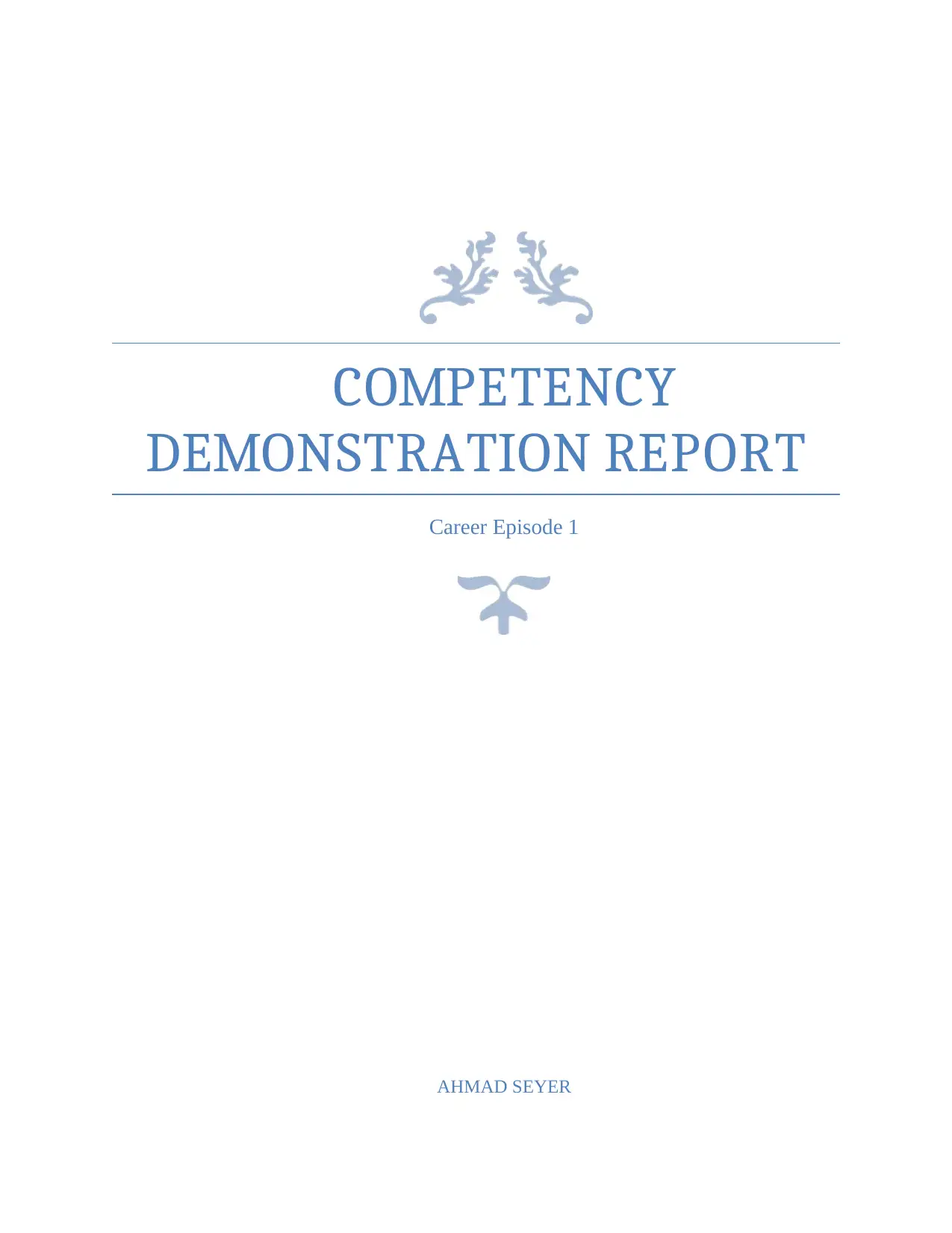
COMPETENCY
DEMONSTRATION REPORT
Career Episode 1
AHMAD SEYER
DEMONSTRATION REPORT
Career Episode 1
AHMAD SEYER
Paraphrase This Document
Need a fresh take? Get an instant paraphrase of this document with our AI Paraphraser
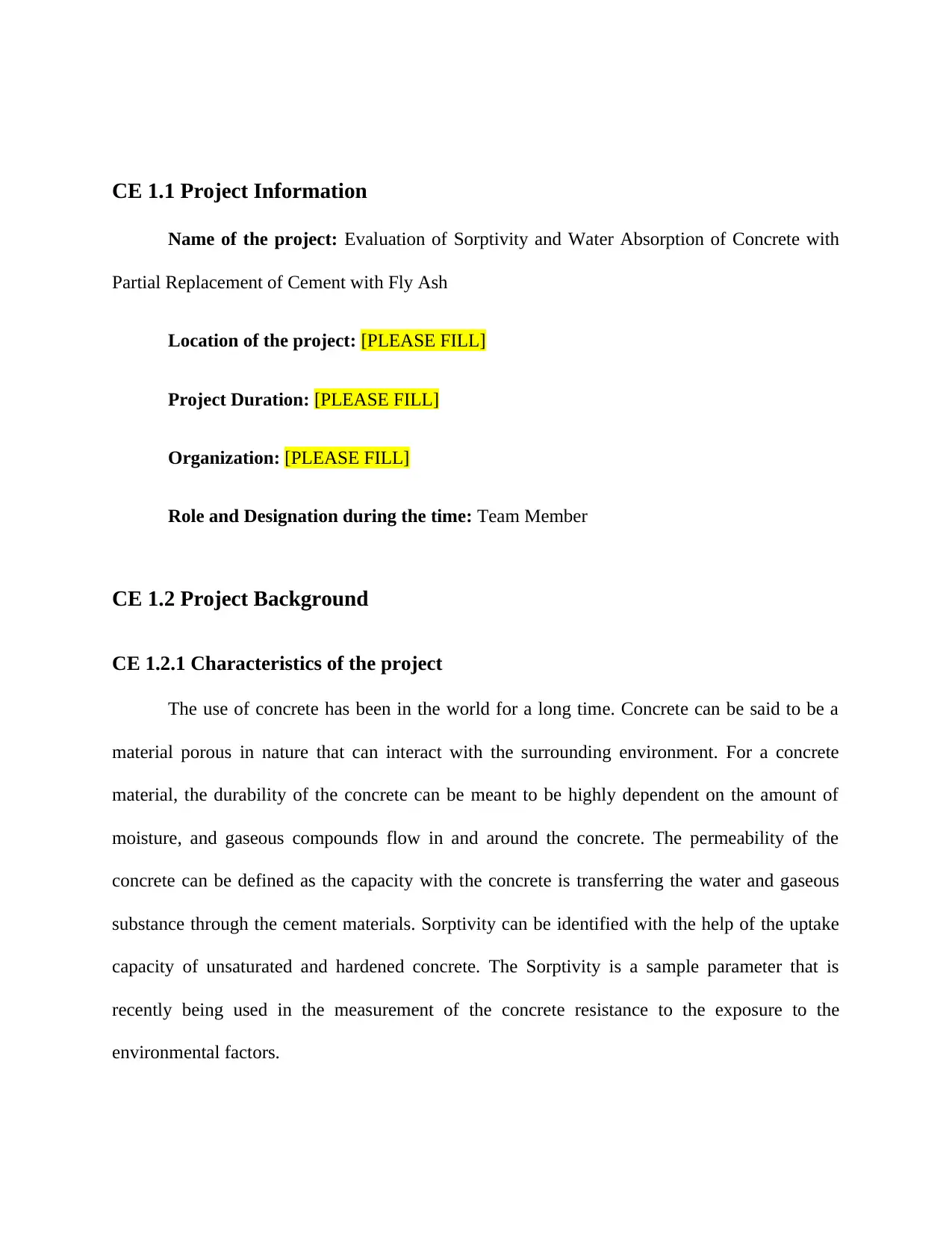
CE 1.1 Project Information
Name of the project: Evaluation of Sorptivity and Water Absorption of Concrete with
Partial Replacement of Cement with Fly Ash
Location of the project: [PLEASE FILL]
Project Duration: [PLEASE FILL]
Organization: [PLEASE FILL]
Role and Designation during the time: Team Member
CE 1.2 Project Background
CE 1.2.1 Characteristics of the project
The use of concrete has been in the world for a long time. Concrete can be said to be a
material porous in nature that can interact with the surrounding environment. For a concrete
material, the durability of the concrete can be meant to be highly dependent on the amount of
moisture, and gaseous compounds flow in and around the concrete. The permeability of the
concrete can be defined as the capacity with the concrete is transferring the water and gaseous
substance through the cement materials. Sorptivity can be identified with the help of the uptake
capacity of unsaturated and hardened concrete. The Sorptivity is a sample parameter that is
recently being used in the measurement of the concrete resistance to the exposure to the
environmental factors.
Name of the project: Evaluation of Sorptivity and Water Absorption of Concrete with
Partial Replacement of Cement with Fly Ash
Location of the project: [PLEASE FILL]
Project Duration: [PLEASE FILL]
Organization: [PLEASE FILL]
Role and Designation during the time: Team Member
CE 1.2 Project Background
CE 1.2.1 Characteristics of the project
The use of concrete has been in the world for a long time. Concrete can be said to be a
material porous in nature that can interact with the surrounding environment. For a concrete
material, the durability of the concrete can be meant to be highly dependent on the amount of
moisture, and gaseous compounds flow in and around the concrete. The permeability of the
concrete can be defined as the capacity with the concrete is transferring the water and gaseous
substance through the cement materials. Sorptivity can be identified with the help of the uptake
capacity of unsaturated and hardened concrete. The Sorptivity is a sample parameter that is
recently being used in the measurement of the concrete resistance to the exposure to the
environmental factors.
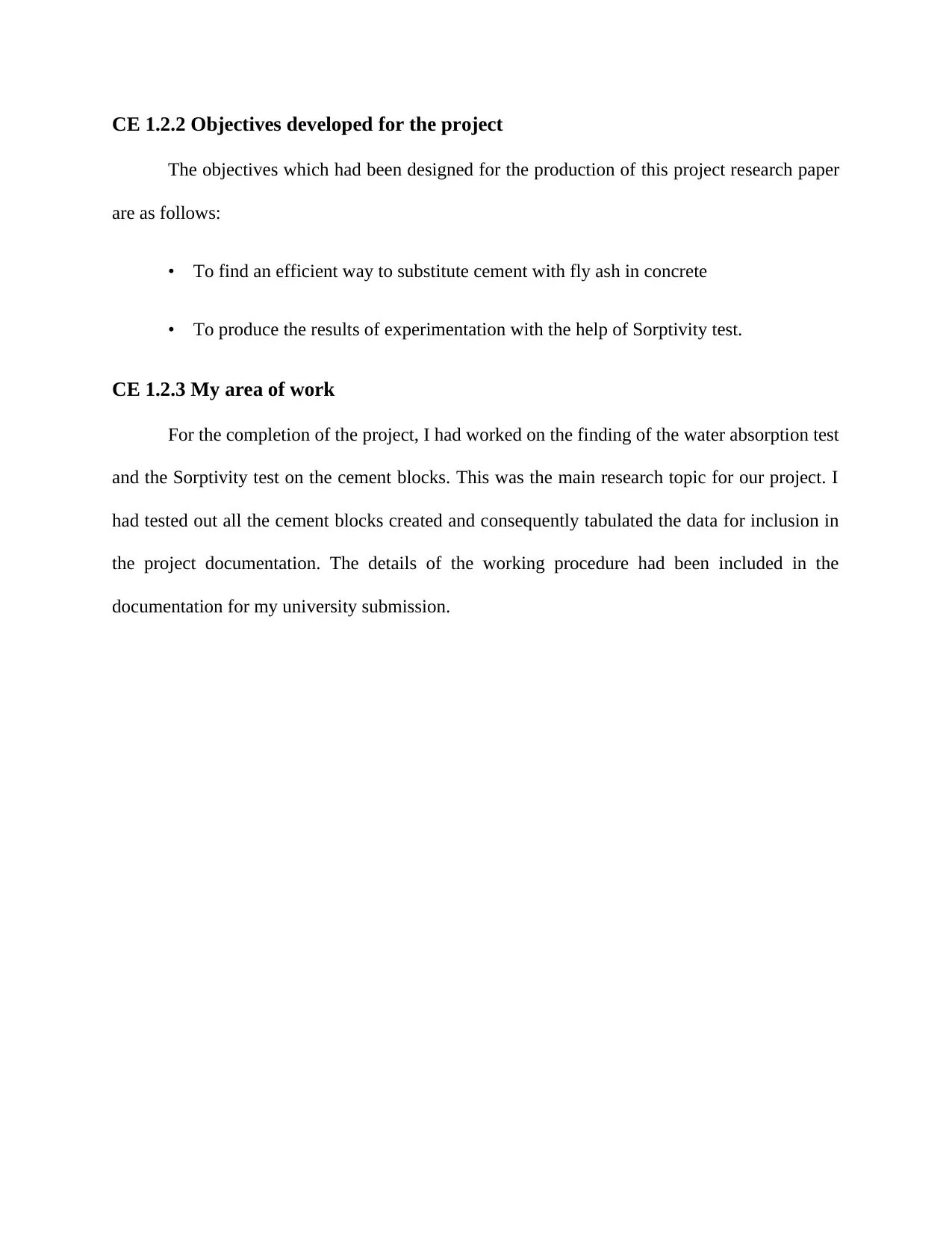
CE 1.2.2 Objectives developed for the project
The objectives which had been designed for the production of this project research paper
are as follows:
• To find an efficient way to substitute cement with fly ash in concrete
• To produce the results of experimentation with the help of Sorptivity test.
CE 1.2.3 My area of work
For the completion of the project, I had worked on the finding of the water absorption test
and the Sorptivity test on the cement blocks. This was the main research topic for our project. I
had tested out all the cement blocks created and consequently tabulated the data for inclusion in
the project documentation. The details of the working procedure had been included in the
documentation for my university submission.
The objectives which had been designed for the production of this project research paper
are as follows:
• To find an efficient way to substitute cement with fly ash in concrete
• To produce the results of experimentation with the help of Sorptivity test.
CE 1.2.3 My area of work
For the completion of the project, I had worked on the finding of the water absorption test
and the Sorptivity test on the cement blocks. This was the main research topic for our project. I
had tested out all the cement blocks created and consequently tabulated the data for inclusion in
the project documentation. The details of the working procedure had been included in the
documentation for my university submission.
⊘ This is a preview!⊘
Do you want full access?
Subscribe today to unlock all pages.

Trusted by 1+ million students worldwide
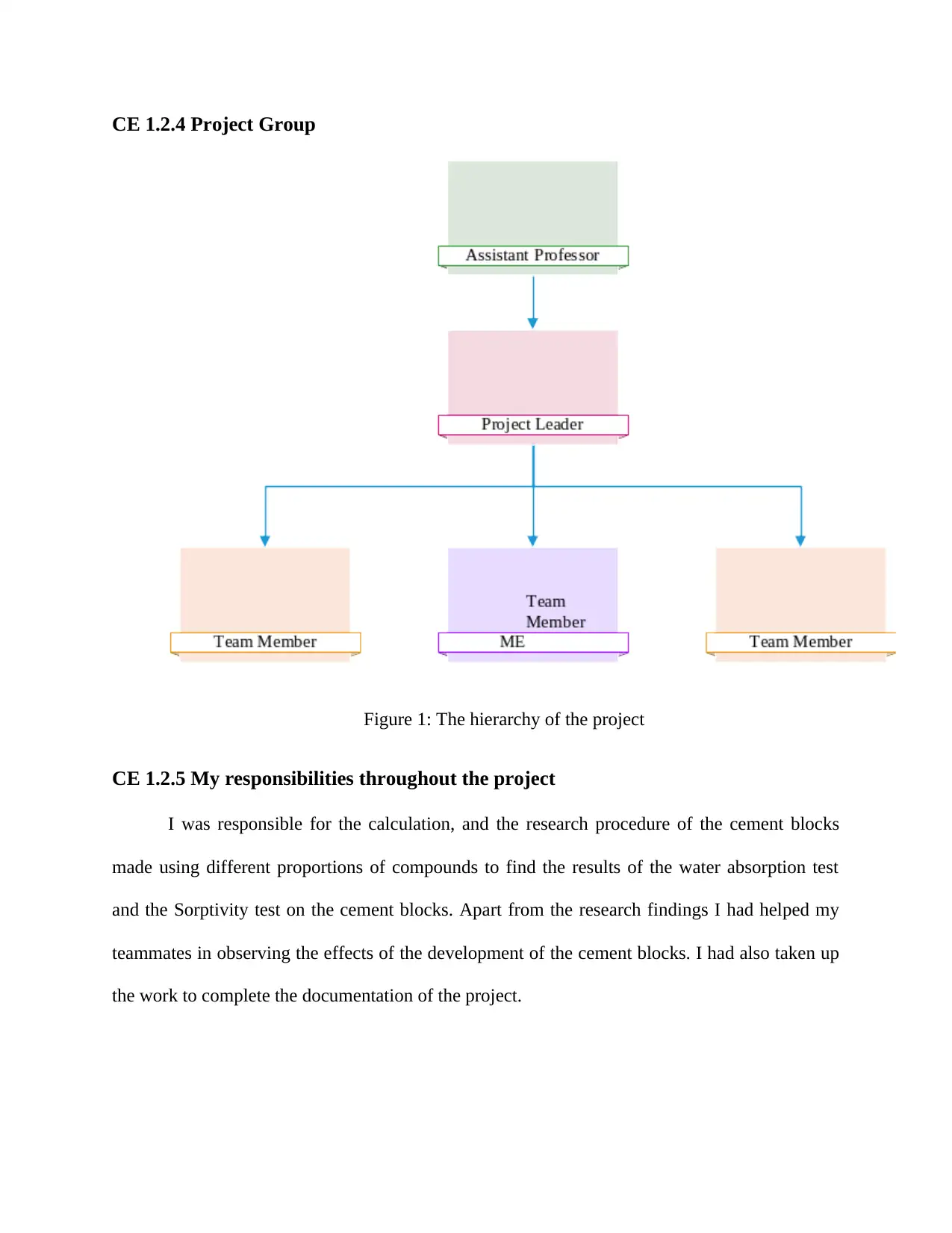
CE 1.2.4 Project Group
Figure 1: The hierarchy of the project
CE 1.2.5 My responsibilities throughout the project
I was responsible for the calculation, and the research procedure of the cement blocks
made using different proportions of compounds to find the results of the water absorption test
and the Sorptivity test on the cement blocks. Apart from the research findings I had helped my
teammates in observing the effects of the development of the cement blocks. I had also taken up
the work to complete the documentation of the project.
Figure 1: The hierarchy of the project
CE 1.2.5 My responsibilities throughout the project
I was responsible for the calculation, and the research procedure of the cement blocks
made using different proportions of compounds to find the results of the water absorption test
and the Sorptivity test on the cement blocks. Apart from the research findings I had helped my
teammates in observing the effects of the development of the cement blocks. I had also taken up
the work to complete the documentation of the project.
Paraphrase This Document
Need a fresh take? Get an instant paraphrase of this document with our AI Paraphraser
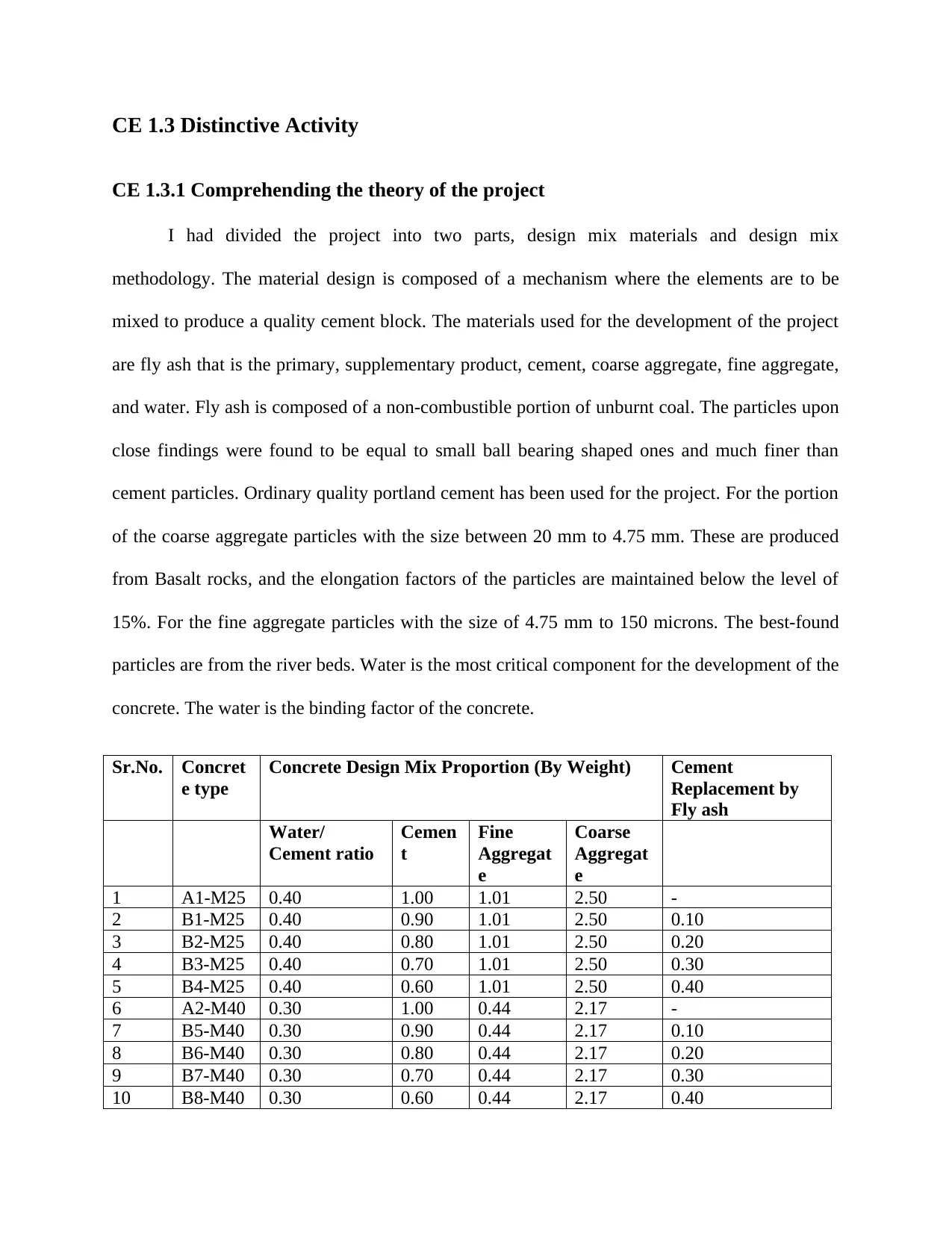
CE 1.3 Distinctive Activity
CE 1.3.1 Comprehending the theory of the project
I had divided the project into two parts, design mix materials and design mix
methodology. The material design is composed of a mechanism where the elements are to be
mixed to produce a quality cement block. The materials used for the development of the project
are fly ash that is the primary, supplementary product, cement, coarse aggregate, fine aggregate,
and water. Fly ash is composed of a non-combustible portion of unburnt coal. The particles upon
close findings were found to be equal to small ball bearing shaped ones and much finer than
cement particles. Ordinary quality portland cement has been used for the project. For the portion
of the coarse aggregate particles with the size between 20 mm to 4.75 mm. These are produced
from Basalt rocks, and the elongation factors of the particles are maintained below the level of
15%. For the fine aggregate particles with the size of 4.75 mm to 150 microns. The best-found
particles are from the river beds. Water is the most critical component for the development of the
concrete. The water is the binding factor of the concrete.
Sr.No. Concret
e type
Concrete Design Mix Proportion (By Weight) Cement
Replacement by
Fly ash
Water/
Cement ratio
Cemen
t
Fine
Aggregat
e
Coarse
Aggregat
e
1 A1-M25 0.40 1.00 1.01 2.50 -
2 B1-M25 0.40 0.90 1.01 2.50 0.10
3 B2-M25 0.40 0.80 1.01 2.50 0.20
4 B3-M25 0.40 0.70 1.01 2.50 0.30
5 B4-M25 0.40 0.60 1.01 2.50 0.40
6 A2-M40 0.30 1.00 0.44 2.17 -
7 B5-M40 0.30 0.90 0.44 2.17 0.10
8 B6-M40 0.30 0.80 0.44 2.17 0.20
9 B7-M40 0.30 0.70 0.44 2.17 0.30
10 B8-M40 0.30 0.60 0.44 2.17 0.40
CE 1.3.1 Comprehending the theory of the project
I had divided the project into two parts, design mix materials and design mix
methodology. The material design is composed of a mechanism where the elements are to be
mixed to produce a quality cement block. The materials used for the development of the project
are fly ash that is the primary, supplementary product, cement, coarse aggregate, fine aggregate,
and water. Fly ash is composed of a non-combustible portion of unburnt coal. The particles upon
close findings were found to be equal to small ball bearing shaped ones and much finer than
cement particles. Ordinary quality portland cement has been used for the project. For the portion
of the coarse aggregate particles with the size between 20 mm to 4.75 mm. These are produced
from Basalt rocks, and the elongation factors of the particles are maintained below the level of
15%. For the fine aggregate particles with the size of 4.75 mm to 150 microns. The best-found
particles are from the river beds. Water is the most critical component for the development of the
concrete. The water is the binding factor of the concrete.
Sr.No. Concret
e type
Concrete Design Mix Proportion (By Weight) Cement
Replacement by
Fly ash
Water/
Cement ratio
Cemen
t
Fine
Aggregat
e
Coarse
Aggregat
e
1 A1-M25 0.40 1.00 1.01 2.50 -
2 B1-M25 0.40 0.90 1.01 2.50 0.10
3 B2-M25 0.40 0.80 1.01 2.50 0.20
4 B3-M25 0.40 0.70 1.01 2.50 0.30
5 B4-M25 0.40 0.60 1.01 2.50 0.40
6 A2-M40 0.30 1.00 0.44 2.17 -
7 B5-M40 0.30 0.90 0.44 2.17 0.10
8 B6-M40 0.30 0.80 0.44 2.17 0.20
9 B7-M40 0.30 0.70 0.44 2.17 0.30
10 B8-M40 0.30 0.60 0.44 2.17 0.40
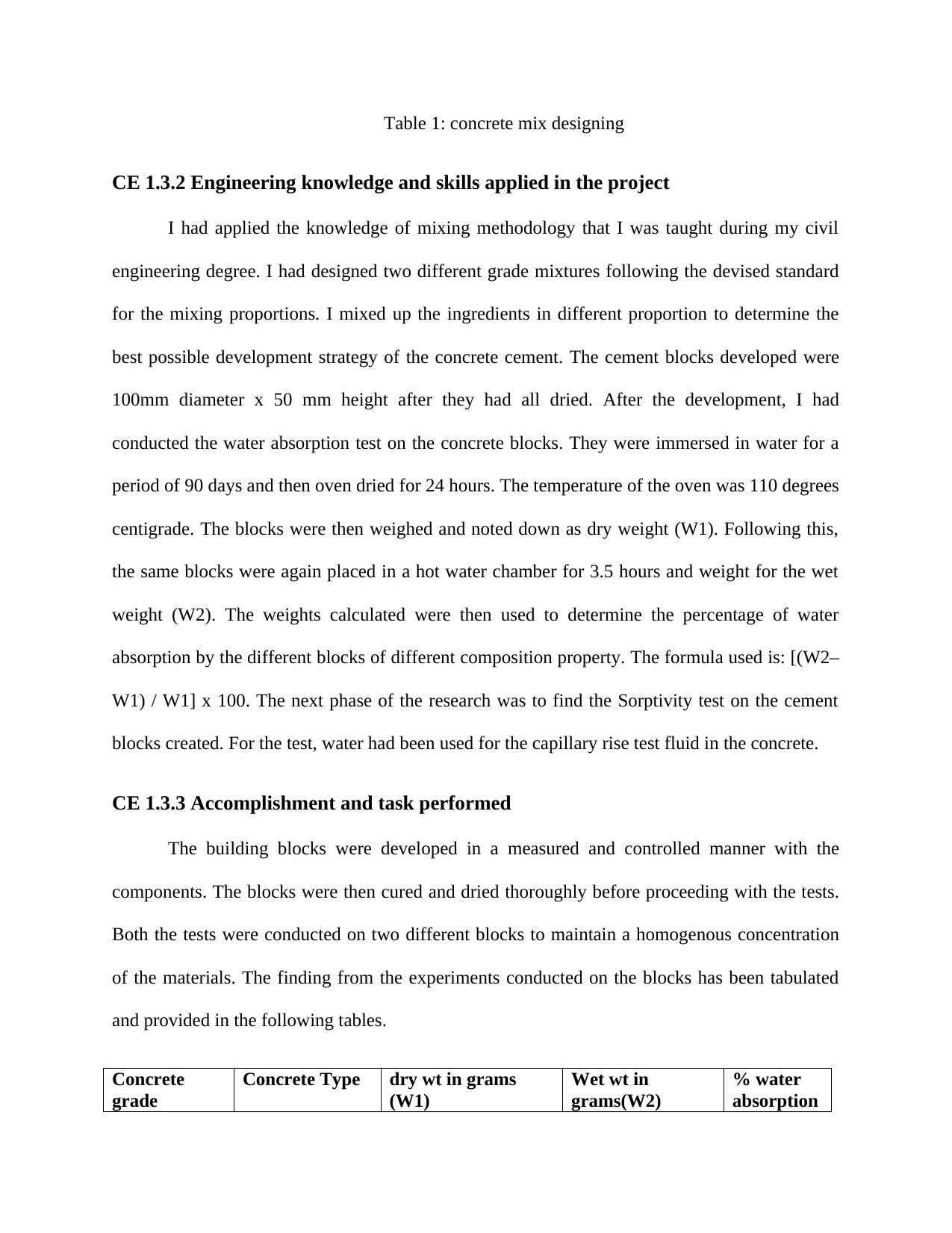
Table 1: concrete mix designing
CE 1.3.2 Engineering knowledge and skills applied in the project
I had applied the knowledge of mixing methodology that I was taught during my civil
engineering degree. I had designed two different grade mixtures following the devised standard
for the mixing proportions. I mixed up the ingredients in different proportion to determine the
best possible development strategy of the concrete cement. The cement blocks developed were
100mm diameter x 50 mm height after they had all dried. After the development, I had
conducted the water absorption test on the concrete blocks. They were immersed in water for a
period of 90 days and then oven dried for 24 hours. The temperature of the oven was 110 degrees
centigrade. The blocks were then weighed and noted down as dry weight (W1). Following this,
the same blocks were again placed in a hot water chamber for 3.5 hours and weight for the wet
weight (W2). The weights calculated were then used to determine the percentage of water
absorption by the different blocks of different composition property. The formula used is: [(W2–
W1) / W1] x 100. The next phase of the research was to find the Sorptivity test on the cement
blocks created. For the test, water had been used for the capillary rise test fluid in the concrete.
CE 1.3.3 Accomplishment and task performed
The building blocks were developed in a measured and controlled manner with the
components. The blocks were then cured and dried thoroughly before proceeding with the tests.
Both the tests were conducted on two different blocks to maintain a homogenous concentration
of the materials. The finding from the experiments conducted on the blocks has been tabulated
and provided in the following tables.
Concrete
grade
Concrete Type dry wt in grams
(W1)
Wet wt in
grams(W2)
% water
absorption
CE 1.3.2 Engineering knowledge and skills applied in the project
I had applied the knowledge of mixing methodology that I was taught during my civil
engineering degree. I had designed two different grade mixtures following the devised standard
for the mixing proportions. I mixed up the ingredients in different proportion to determine the
best possible development strategy of the concrete cement. The cement blocks developed were
100mm diameter x 50 mm height after they had all dried. After the development, I had
conducted the water absorption test on the concrete blocks. They were immersed in water for a
period of 90 days and then oven dried for 24 hours. The temperature of the oven was 110 degrees
centigrade. The blocks were then weighed and noted down as dry weight (W1). Following this,
the same blocks were again placed in a hot water chamber for 3.5 hours and weight for the wet
weight (W2). The weights calculated were then used to determine the percentage of water
absorption by the different blocks of different composition property. The formula used is: [(W2–
W1) / W1] x 100. The next phase of the research was to find the Sorptivity test on the cement
blocks created. For the test, water had been used for the capillary rise test fluid in the concrete.
CE 1.3.3 Accomplishment and task performed
The building blocks were developed in a measured and controlled manner with the
components. The blocks were then cured and dried thoroughly before proceeding with the tests.
Both the tests were conducted on two different blocks to maintain a homogenous concentration
of the materials. The finding from the experiments conducted on the blocks has been tabulated
and provided in the following tables.
Concrete
grade
Concrete Type dry wt in grams
(W1)
Wet wt in
grams(W2)
% water
absorption
⊘ This is a preview!⊘
Do you want full access?
Subscribe today to unlock all pages.

Trusted by 1+ million students worldwide
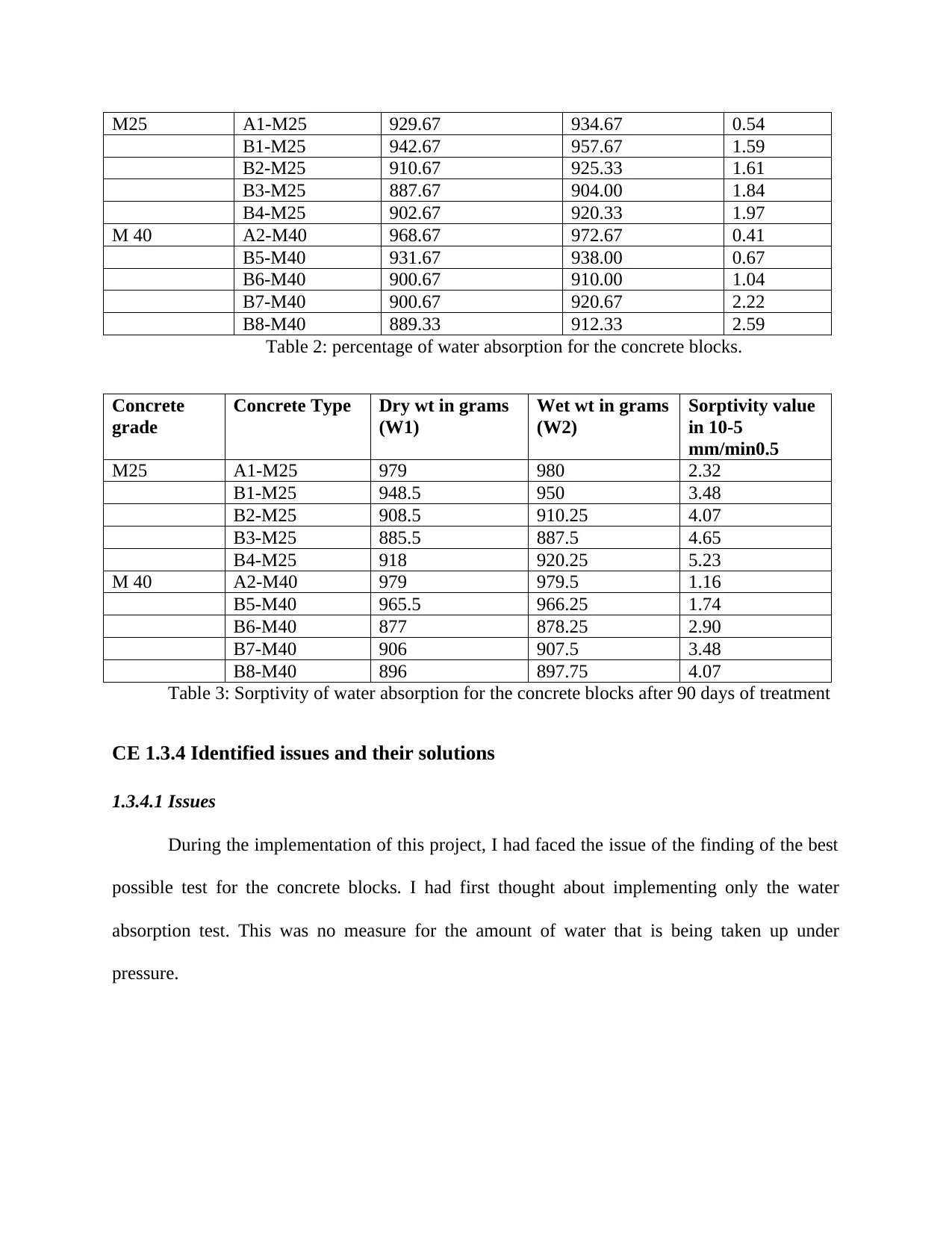
M25 A1-M25 929.67 934.67 0.54
B1-M25 942.67 957.67 1.59
B2-M25 910.67 925.33 1.61
B3-M25 887.67 904.00 1.84
B4-M25 902.67 920.33 1.97
M 40 A2-M40 968.67 972.67 0.41
B5-M40 931.67 938.00 0.67
B6-M40 900.67 910.00 1.04
B7-M40 900.67 920.67 2.22
B8-M40 889.33 912.33 2.59
Table 2: percentage of water absorption for the concrete blocks.
Concrete
grade
Concrete Type Dry wt in grams
(W1)
Wet wt in grams
(W2)
Sorptivity value
in 10-5
mm/min0.5
M25 A1-M25 979 980 2.32
B1-M25 948.5 950 3.48
B2-M25 908.5 910.25 4.07
B3-M25 885.5 887.5 4.65
B4-M25 918 920.25 5.23
M 40 A2-M40 979 979.5 1.16
B5-M40 965.5 966.25 1.74
B6-M40 877 878.25 2.90
B7-M40 906 907.5 3.48
B8-M40 896 897.75 4.07
Table 3: Sorptivity of water absorption for the concrete blocks after 90 days of treatment
CE 1.3.4 Identified issues and their solutions
1.3.4.1 Issues
During the implementation of this project, I had faced the issue of the finding of the best
possible test for the concrete blocks. I had first thought about implementing only the water
absorption test. This was no measure for the amount of water that is being taken up under
pressure.
B1-M25 942.67 957.67 1.59
B2-M25 910.67 925.33 1.61
B3-M25 887.67 904.00 1.84
B4-M25 902.67 920.33 1.97
M 40 A2-M40 968.67 972.67 0.41
B5-M40 931.67 938.00 0.67
B6-M40 900.67 910.00 1.04
B7-M40 900.67 920.67 2.22
B8-M40 889.33 912.33 2.59
Table 2: percentage of water absorption for the concrete blocks.
Concrete
grade
Concrete Type Dry wt in grams
(W1)
Wet wt in grams
(W2)
Sorptivity value
in 10-5
mm/min0.5
M25 A1-M25 979 980 2.32
B1-M25 948.5 950 3.48
B2-M25 908.5 910.25 4.07
B3-M25 885.5 887.5 4.65
B4-M25 918 920.25 5.23
M 40 A2-M40 979 979.5 1.16
B5-M40 965.5 966.25 1.74
B6-M40 877 878.25 2.90
B7-M40 906 907.5 3.48
B8-M40 896 897.75 4.07
Table 3: Sorptivity of water absorption for the concrete blocks after 90 days of treatment
CE 1.3.4 Identified issues and their solutions
1.3.4.1 Issues
During the implementation of this project, I had faced the issue of the finding of the best
possible test for the concrete blocks. I had first thought about implementing only the water
absorption test. This was no measure for the amount of water that is being taken up under
pressure.
Paraphrase This Document
Need a fresh take? Get an instant paraphrase of this document with our AI Paraphraser
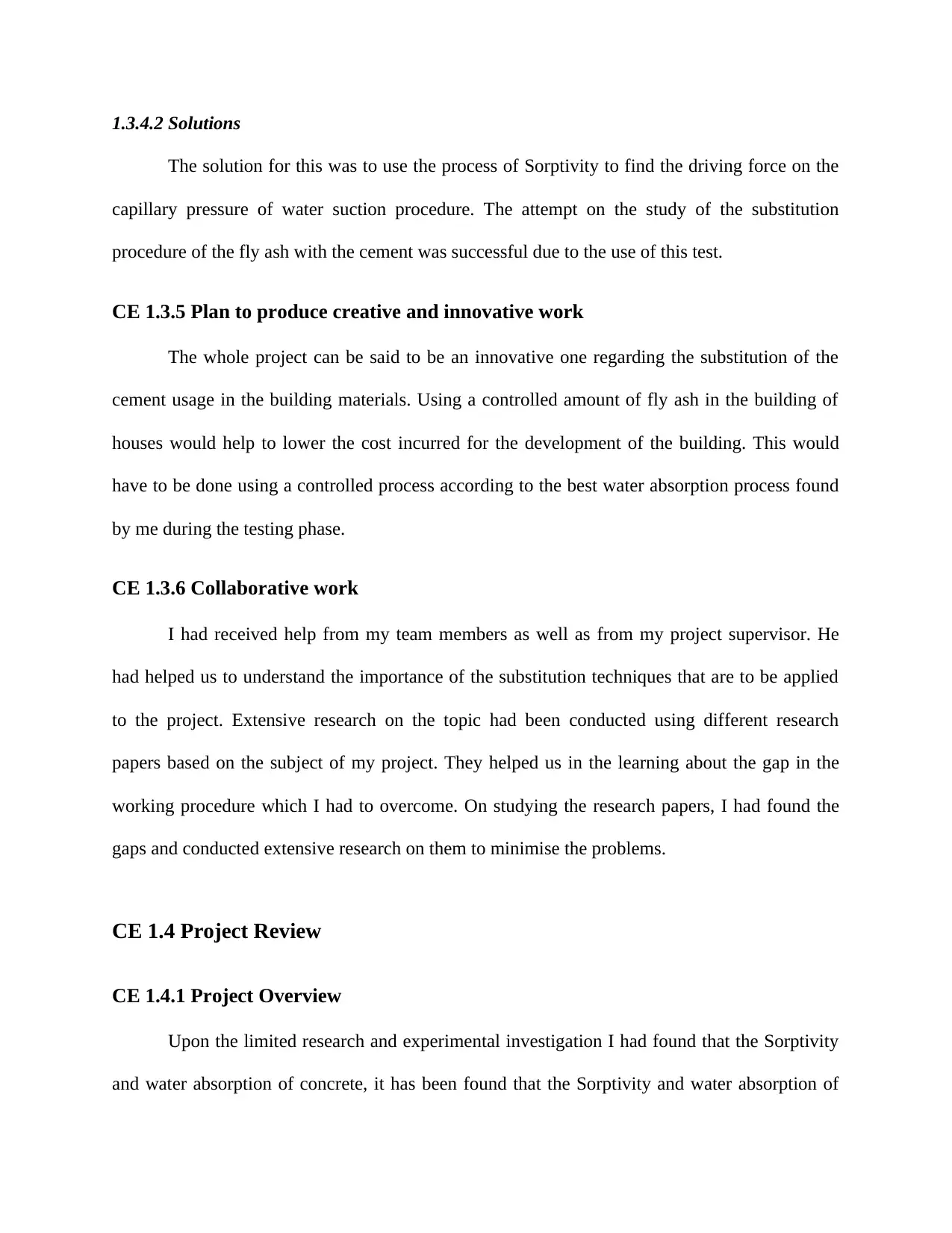
1.3.4.2 Solutions
The solution for this was to use the process of Sorptivity to find the driving force on the
capillary pressure of water suction procedure. The attempt on the study of the substitution
procedure of the fly ash with the cement was successful due to the use of this test.
CE 1.3.5 Plan to produce creative and innovative work
The whole project can be said to be an innovative one regarding the substitution of the
cement usage in the building materials. Using a controlled amount of fly ash in the building of
houses would help to lower the cost incurred for the development of the building. This would
have to be done using a controlled process according to the best water absorption process found
by me during the testing phase.
CE 1.3.6 Collaborative work
I had received help from my team members as well as from my project supervisor. He
had helped us to understand the importance of the substitution techniques that are to be applied
to the project. Extensive research on the topic had been conducted using different research
papers based on the subject of my project. They helped us in the learning about the gap in the
working procedure which I had to overcome. On studying the research papers, I had found the
gaps and conducted extensive research on them to minimise the problems.
CE 1.4 Project Review
CE 1.4.1 Project Overview
Upon the limited research and experimental investigation I had found that the Sorptivity
and water absorption of concrete, it has been found that the Sorptivity and water absorption of
The solution for this was to use the process of Sorptivity to find the driving force on the
capillary pressure of water suction procedure. The attempt on the study of the substitution
procedure of the fly ash with the cement was successful due to the use of this test.
CE 1.3.5 Plan to produce creative and innovative work
The whole project can be said to be an innovative one regarding the substitution of the
cement usage in the building materials. Using a controlled amount of fly ash in the building of
houses would help to lower the cost incurred for the development of the building. This would
have to be done using a controlled process according to the best water absorption process found
by me during the testing phase.
CE 1.3.6 Collaborative work
I had received help from my team members as well as from my project supervisor. He
had helped us to understand the importance of the substitution techniques that are to be applied
to the project. Extensive research on the topic had been conducted using different research
papers based on the subject of my project. They helped us in the learning about the gap in the
working procedure which I had to overcome. On studying the research papers, I had found the
gaps and conducted extensive research on them to minimise the problems.
CE 1.4 Project Review
CE 1.4.1 Project Overview
Upon the limited research and experimental investigation I had found that the Sorptivity
and water absorption of concrete, it has been found that the Sorptivity and water absorption of
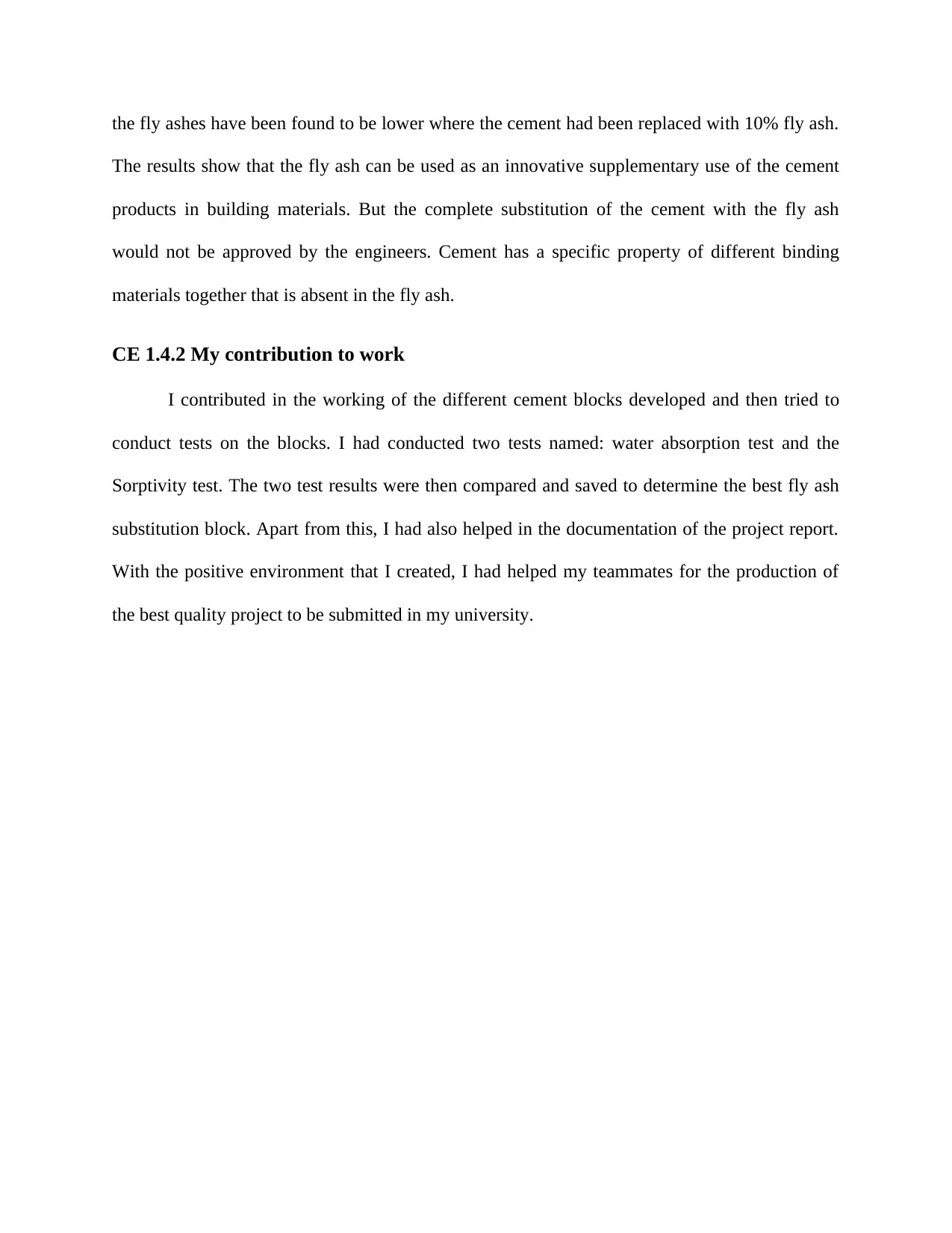
the fly ashes have been found to be lower where the cement had been replaced with 10% fly ash.
The results show that the fly ash can be used as an innovative supplementary use of the cement
products in building materials. But the complete substitution of the cement with the fly ash
would not be approved by the engineers. Cement has a specific property of different binding
materials together that is absent in the fly ash.
CE 1.4.2 My contribution to work
I contributed in the working of the different cement blocks developed and then tried to
conduct tests on the blocks. I had conducted two tests named: water absorption test and the
Sorptivity test. The two test results were then compared and saved to determine the best fly ash
substitution block. Apart from this, I had also helped in the documentation of the project report.
With the positive environment that I created, I had helped my teammates for the production of
the best quality project to be submitted in my university.
The results show that the fly ash can be used as an innovative supplementary use of the cement
products in building materials. But the complete substitution of the cement with the fly ash
would not be approved by the engineers. Cement has a specific property of different binding
materials together that is absent in the fly ash.
CE 1.4.2 My contribution to work
I contributed in the working of the different cement blocks developed and then tried to
conduct tests on the blocks. I had conducted two tests named: water absorption test and the
Sorptivity test. The two test results were then compared and saved to determine the best fly ash
substitution block. Apart from this, I had also helped in the documentation of the project report.
With the positive environment that I created, I had helped my teammates for the production of
the best quality project to be submitted in my university.
⊘ This is a preview!⊘
Do you want full access?
Subscribe today to unlock all pages.

Trusted by 1+ million students worldwide
1 out of 9
Related Documents
Your All-in-One AI-Powered Toolkit for Academic Success.
+13062052269
info@desklib.com
Available 24*7 on WhatsApp / Email
![[object Object]](/_next/static/media/star-bottom.7253800d.svg)
Unlock your academic potential
Copyright © 2020–2025 A2Z Services. All Rights Reserved. Developed and managed by ZUCOL.





